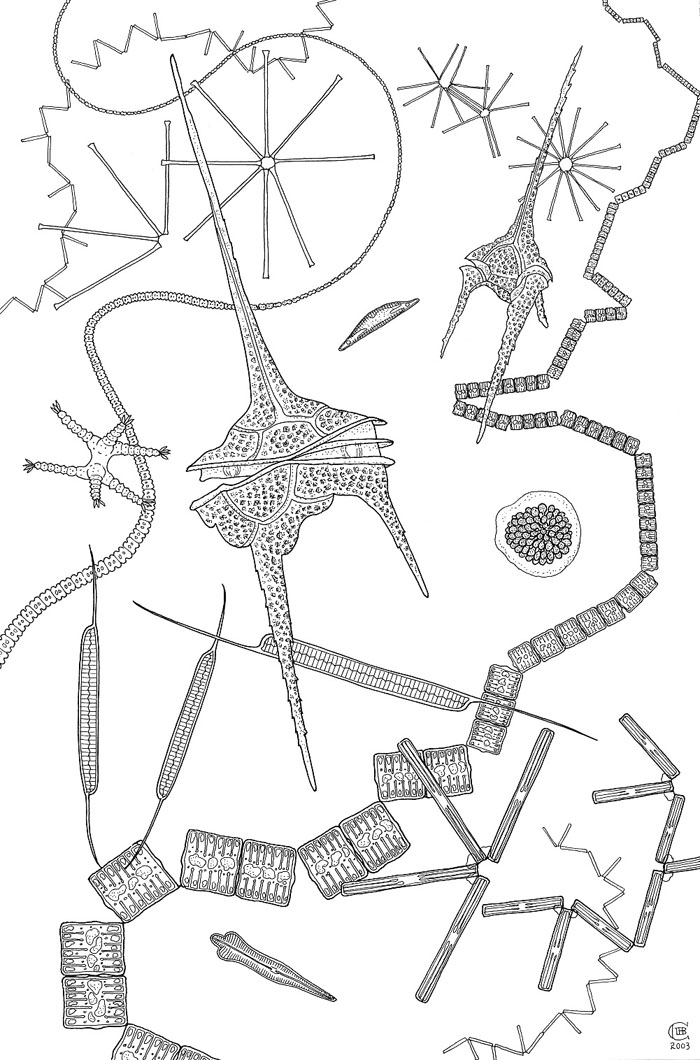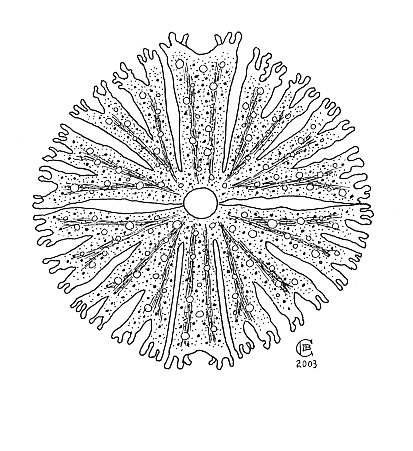
|
Report: British Phycological Society Field Course in Freshwater Algae (Kindrogan, Scotland, August 2003) by Christina Brodie, UK |
Earlier this year, keen to explore the world of microscopic botany further, I took part in a unique course in freshwater algal identification, run by the Field Studies Council in Kindrogan, Scotland; our course tutors were algal experts Eileen Cox and Elliot Shubert, of both the British Phycological Society and Natural History Museum. The article and illustrations below were originally published in the winter 2003 edition of the British Phycological Society's newsletter, The Phycologist.
Some of the illustrations are composite images created from drawings made over the duration of the week-long course. I have tried to convey the effect of a "micro-world" in which algae are depicted living in the underwater environments particular to them.
I arrived at my interest in algae via a somewhat unusual route. Originally having studied fashion and textiles, I moved on to botanical painting and drawing, eventually progressing to drawing microscopic subjects. An admirer of the work of artist Wim van Egmond, whose work can be seen online in microscopy magazine Micscape, and that of the 19th-century German artist Ernst Haeckel, author and illustrator of Art Forms in Nature, I was fascinated by the wealth of shape, form and texture to be found in their observations of microscopic plant life, and was inspired to create similar artwork. It being evident from my early attempts at pond dipping that I needed experience in collecting material, and a better understanding of the organisms viewed down my microscope, I enrolled on the Freshwater Algae course taught annually by Eileen Cox and Elliot Shubert at Kindrogan Field Studies Centre in Perthshire, Scotland.
The course attracted a cosmopolitan range of participants, including biologists from water companies or environmental organisations, PhD students, artists (myself), or those for whom algae was, quite simply, a passion. For me, the course was a good introduction to the algae; for others, it offered a chance to build on prior knowledge.
A typical day would involve a short talk about one of each of the different groups of algae (for example, cyanobacteria or diatoms), a short excursion to a nearby locality to collect material, and identification using microscopes and an impressive selection of texts provided by Eileen and Elliot (Eileen's unique book Identification of Freshwater Diatoms from Live Material rapidly performed several circuits of the class). My main experience of algae had previously been limited to prepared slides as opposed to live material, and I mused on the challenge of following some of the more lively algae around a slide whilst simultaneously trying to draw them. Happily, my task was less difficult than I had expected; even the most meandering diatom, shape-changing euglenoid or tumbling, twirling dinoflagellate will gradually slow down after a while!
During the shorter excursions and the day-long midweek field trip, samples were taken from several localities within the stunning mountainous, forested and moorland Perthshire surroundings. These included lochs that varied in size and altitude, woodland and distillery streams, ponds, puddles and bird-baths! Examining the samples later in the laboratory, it soon became clear that the distribution of algal genera or species could be related to the natures of these water bodies. The water bodies themselves being micro-environments, prevailing environmental conditions within them, and frequency of species in a sample, could be shown to fluctuate considerably over a 24-hour period. A sister course, “Practical Algal Ecology”, running simultaneously and partly taught by guest tutor John Kinross, provided data such as pH, temperature and dissolved oxygen measurements with which to correlate our records of the species found, therefore providing us with an enhanced understanding of species ecology.
By the end of the final day I was amazed to find that I had made drawings of about eighty to ninety different types of algae, approximately half the number we had successfully identified. Making annotated drawings of the algae found had proved invaluable to me over the week, enhancing my knowledge of algal genera and species and serving as an aide-memoire. The final task of the day was an algal count, followed by the time-honoured tradition of algal charades in the bar (which call more for an imitation of algal morphology than a “Give Us A Clue”-style approach, and which provided hilarious entertainment for the OU Geology students).
The course is to be highly recommended for its professionalism, its direct relevance to a wide spectrum of biological and environmental applications, high quality of teaching and resources and immaculate presentation of learning materials (a quick-reference booklet for us to keep). It is suited both to the professional who would like to improve their taxonomy, and to the beginner like myself, keen to develop their understanding of and interest in algae. I gained an immense amount from it, and would rate it as being excellent in every way.
For more information about the course, please visit the Field Studies Council website at www.field-studies-council.org. The course is normally held in late July/early August. Students may be eligible to receive support from the British Phycological Society towards the cost of the course; for additional information, please visit the British Phycological society website at www.brphycsoc.org.
Please contact the author, Christina Brodie via her website www.queen-christina.com if there are requests about image use or if interested in her other artwork.
All images © Christina Brodie 2003.
Flora from Loch Tummel.
Pictured are the dinoflagellates Ceratium corundum and Ceratium
hirundinella, resembling the Eiffel Tower; the blue-green alga
Coelosphaerium kuetzingianum, encircled by a ring of mucilage; the
diatoms Uroselenia eriensis, Tabellaria species, and
Asterionella formosa, with its star-like colonies; and the desmids
Staurastrum planctonicum and Spondylosum
planum.
|
Flora from the River Ardle.
The centre of the picture is dominated by the large stalked diatom
Didymosphenia, which itself plays host to a smaller stalked
diatom, Achnanthidium minutissima. Likewise attached to the rocks is a
red freshwater alga, Audoniella herrmanniana. To the left of
Didymosphenia are a grain of Pinus pollen and a string of
Encyonemas dividing in a mucilage tube. Floating in the river current
is the colonial diatom Fragilaria capucina and various filamentous
green algae (Spirogyra, Zygnema, Ulothrix).
|

Micrasterias sol.
Loch Kinardochy, source of Micrasterias sol.
Please report any Web problems or offer general comments to the Micscape Editor.
Micscape is the on-line monthly magazine of
the Microscopy UK web
site at Microscopy-UK.